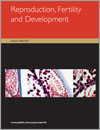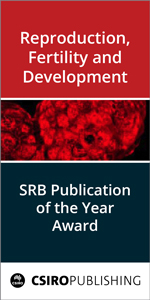Reproduction, Fertility and Development
Volume 29
Number 8 2017
This review describes the involvement of the sodium pump Na+/K+-ATPase in various aspects of animal reproduction, including critical roles in embryonic development and specific sperm functions. In addition to regulating ion concentrations, Na+/K+-ATPase participates in several cell signalling pathways. Understanding the role of this molecule creates new opportunities to enhance or suppress various aspects of reproductive biology.
Several hypotheses have been proposed to explain the negative effects of delayed motherhood on an offspring’s morbidity later in life, but they are not supported by clinical and epidemiological evidence. In the present study, we show that the negative effects on offspring of delayed motherhood may be induced by embryo or fetal epigenetic DNA reprogramming associated with maternal age-related obstetric complications. This outcome has direct clinical implications for those women wanting to enrol in a fertility preservation program to offset age-related declines in fertility.
This paper reports that pregnant mice deficient in relaxin (Rln–/–) did not exhibit characteristics associated with preeclampsia; plasma sFlt-1 concentrations and blood pressure in pregnant Rln–/– mice were no different compared with age-matched wildtype mice. Although there was evidence of proteinuria in older pregnant Rln–/– mice, this was also observed in non-pregnant mice and was not a consequence of pregnancy. Therefore, pregnant Rln–/– mice are not a suitable animal model to study preeclampsia.
We found that cheetahs do not display typical estrous cycles, but rather frequent waves of estrogenic activity every 7 to 10 days. For effective ovulation induction and the most mature oocytes, gonadotropin treatments had to be given at least 3 days after an estrogen peak. Follicular activity can be suppressed by progestin supplementation, thereby providing a way to quiesce the ovary beforehand.
A restricted diet applied to females during the peri-conceptional period may have consequences during the peri-implantation period. In this study we examined DNA methyltransferase 1 (DNMT1) and DNMT3a expression in endometrium and myometrium and oestradiol 17β (E2) and progesterone concentrations in the uterus and blood plasma in pigs during the peri-implantation period. Undernutrition during the peri-conceptional period affects maintenance and de novo DNA methylation in the endometrium, de novo DNA methylation in the myometrium and intrauterine E2 concentrations during the peri-implantation period.
Aberrant DNA methylation has been linked to deficiencies in trophoblast motility and invasion in pregnancy complications. We increased trophoblast cell motility and invasiveness through inducing site-specific hypermethylation and repressing gene expression of CDH1 by sense-methylated oligonucleotides (MONs). The results indicate that MON-mediated DNA methylation on the CDH1 promoter may alter gene expression and contribute to trophoblast motility and invasion.
Macrophage migration inhibitory factor (MIF) may be the molecular link between maternal obesity and the quality of early embryos. This study revealed that MIF expression in the oviduct, where mammalian embryos spend their first 3 days, is higher during the postovulatory phase than during oestrus and the luteal phase in heifers. Therefore, oviduct MIF may be essential for producing good-quality embryos.
The aim of this study was to explore the mechanism of action of stathmin 1 (Stmn1), a protein identified by two-dimensional electrophoresis (2-DE) and mass spectrometry (MS) in a previous proteomic analysis, in regulating embryo implantation, a critical process in pregnancy. Stmn1 was found to play a role in decidualisation and embryo implantation by inhibiting the expression of phosphorylated Akt, hypoxia-inducible factor-1α and vascular endothelial growth factor. These findings contribute to a better understanding of the potential role of Stmn1 during embryo implantation.
The developmental potential of follicles from a mouse model of premature ovarian insufficiency (POI) was assessed using follicle culture. Although, follicles cultured from 3- and 6-week-old mice had decreased survival compared to Controls, a population of follicles retain the potential of full development in vitro. These results indicate that in vitro follicle culture is a promising method to rescue follicle development after the onset of POI in this model.
MicroRNAs (miRNAs) control several reproductive functions, including oocyte maturation, implantation and early embryonic development. We developed a method for accurate miRNA identification in a small sample of bovine blastocysts. Using pools of only 30 embryos, we identified miRNAs that regulate target genes and metabolic pathways that had not been associated with early embryogenesis before, and are potential biomarkers of developmental competence.
Xenopus frogs are key organisms for studying basic biology and for modelling human disease. Genetically altered lines of frogs are therefore made, and it is important for animal welfare and cost-effectiveness to store these as frozen spermatozoa. In this study we show that Xenopus sperm cryopreservation damages the DNA and plasma membrane of spermatozoa and start to identify factors affecting damage levels.
Several voltage-gated K+ (Kv) channel subunits are expressed in testis, but their contribution to testicular function remains largely unknown. We provide direct evidence of the relevance of Kv6.4 for male fertility since the targeted deletion of this gene in mice disrupted spermiogenesis, resulting in male sterility. This makes Kv6.4 a potentially interesting pharmacological target for the development of non-hormonal male contraceptives.
Seminal plasma could benefit boar semen when added during thawing. This study shows that that the addition of 10% or 50% seminal plasma during post-thawing incubation improved total motility and the motility pattern (motile subpopulations) of spermatozoa. Chromatin changes were almost non-existent for samples from some male boars, both after thawing and during the incubation, but in males susceptible to these sorts of chromatin changes, seminal plasma reduced or abolished them.
The mechanism by which valproic acid (VPA) causes male infertility is not known. In the present study, testicular proteins and acrosome status were investigated in VPA-treated rats. Acrosome reacted spermatozoa and the expression of Ki-67, cholesterol side-chain cleavage enzyme (P450scc) and tyrosine phosphorylated proteins, except for steroidogenic acute regulatory protein, were decreased in VPA-treated rats. These changes to testicular proteins responsible for spermatogenesis result in male infertility after VPA treatment.
Serum affects lipid metabolism in oocytes and embryos, and cGMP has been shown to affect lipolysis in adipocytes. The present study shows that serum in the maturation medium interferes with lipid metabolism in oocytes and cumulus cells and these effects depend, at least in part, on the cGMP pathway. Evidence of involvement of this pathway in lipolysis in cumulus–oocyte complexes could contribute to the development of better culture systems for the in vitro production of oocytes and embryos with lower lipid accumulation and better cryotolerance.
We recently discovered that the male seminal vesicles harbour a novel seminal fluid microbiome (SFM). The present study shows that short-term feeding of a high-fat diet (HFD) changes the bacterial composition of the seminal fluid and fecal microbiomes. HFD-induced SFM alterations might lead to detrimental health consequences in males, their reproductive partners and resulting offspring.
This study aimed to explore the mechanisms underlying the pathogenesis of unexplained recurrent spontaneous abortion (URSA). The results suggest that the balance between C-type lectin-like receptors and Toll-like receptors (TLRs) was tilted towards a TLR-dominant response in URSA patients, which may disrupt maternal–fetal immune tolerance, resulting in spontaneous abortion.
The quality of oocytes is a crucial factor in the field of reproductive biotechnology. We observed that maturation of pig oocytes in hypotonic medium with reduced NaCl improves the developmental competence of oocytes by affecting the cytoplasmic microenvironment. An oocyte maturation system using a medium with reduced NaCl could potentially improve the efficiency of reproduction in livestock species after further optimisation.
Sertoli cells, which support and coordinate developing sperm in the testes, were isolated from 8-week-old Holstein bull calves. A combination of two hormones (IGF-I and FSH) enhanced multiplication of Sertoli cells. We concluded that increased IGF-I concentrations in bull calves fed high-levels of nutrition during early life increases Sertoli cell number, supports testicular development and results in earlier puberty.
Anti-Müllerian hormone (AMH) has been proposed as a biomarker of ovarian reserve in women and has been detected in many species; however, this is the first characterisation of AMH in a cetacean. AMH was described in males and females from the year of birth to over 30 years of age during different reproductive seasons, and a decrease in AMH in older animals (>30 years old) was detected. AMH may be of value for reproductive health monitoring of the species and as a biomarker of reproductive senescence in both sexes.




